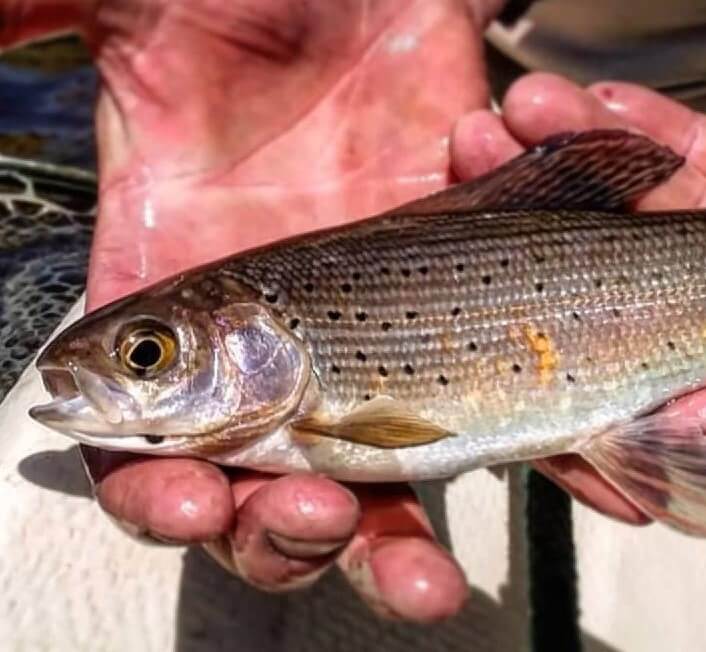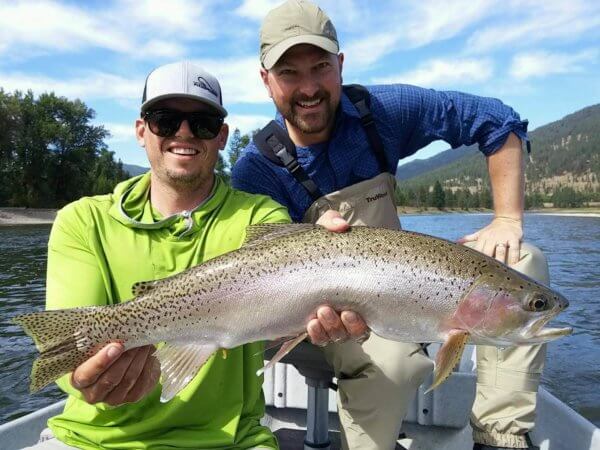Grayling

The Grayling is one of the most magnificent, beautiful salmonids in Montana. While a member of the trout family, like the Bull Trout and Brook trout, it’s not a true trout like a Brown Trout or Rainbow. The most impressive feature of the Grayling is the massive dorsal fin, which is wildly colored and the most distinguishing characteristic of the Grayling. Grayling are fall spawners, and if you want to see that massive dorsal fin in all its magnificence, find them when they’re spawning! Missoula Grayling are found in our alpine lakes, and once located, it’s so much fun. If you think the Cutthroat Trout is free rising, you ain’t seen nothing yet! Tie on a small, gray dry fly, and you can catch as many grayling as you care to. While it’s not local to Missoula, the only population of fluvial Grayling in the Lower 48 are found in the upper stretches of the Big Hole River, where they can reach up to 18” in size. If you need to take a Grayling in a river, you can find them less than a 2.5 hour drive from Missoula. We can’t say the Grayling is populous or common, but if you take the time, you can find them around Missoula.
Lake Trout

The lake Trout is a native Montana fish, holding over from the glaciers in a few northern Montana lakes. They are also found in Flathead, though they are not native to that watershed. As juveniles (up to 2-3 lbs) Lake Trout are plankton eaters, but once they get over three pounds, their diet changes over to fish. Lake Trout are not a favored species for Montana fly fishing. They tend to school and hold in deep water. Those who pursue lake Trout do so with very specialized tackle like fish finders and downriggers. However, there are times when the Lake Trout will follow schools of baitfish into the shallows. If you’re there when that happens, the fishing can be absolutely amazing. It’s not often you get a chance to cast a streamer to a 10 pound cruising fish of any species. We try and keep our ear to the ground, but truthfully, the anglers who look for this phenomena are fairly close lipped! If you do pursue Lake Trout, be aware Montana FWP has guidelines for consumption. Click here to access that information.
Lake Whitefish
The Lake Whitefish, or Lake Superior Whitefish, is a non-native species planted in Flathead and other Montana lakes in the early 1900’s. They live near the bottom in schools, so when you find one you tend to find a lot. They are big for Whitefish, averaging 2-4 pounds, and unlike the native Mountain Whitefish have a firm, delicious flesh that is edible year round. On Flathead Lake, you can find lake Whitefish in shallower water, chasing the Yellow Perch fry. This occurs late July through August, and the Lake Whitefish are easy to find and easy to catch. A jigging action with anything resembling a perch fry will move fish at this time. If you’re looking for something for the pan, the lake Whitefish is a great species to pursue. You will want to leave your fly rod at home for this species.
Yellow Perch

The Yellow Perch is a non-native species in Montana. It is found in lakes, ponds and reservoirs across the state. They travel in schools, and once you find one, you’ve found a bunch. Many a young, beginning fly fisherman has had their interest renewed by a school of Yellow Perch willing to eat any streamer dragged by. If you’re lucky enough to know somewhere that supports large Yellow Perch, keep it to yourself! Yellow Perch are some of the finest eating fish found in Montana, but in most waters they are small and prolific. Yellow Perch are also the foundation food for other Western Montana fish species like Lake Whitefish and Lake Trout.
Suckers

There is more than one species of sucker found in Missoula rivers and lakes, and truthfully, very few anglers are fond of them! While critical to the health of the rivers, they are not a much loved fish in Missoula fly fishing circles. Suckers usually remain small, though some can get up to 24” long and weigh five pounds. Suckers are spring spawners, and when spawning they become very territorial. To look at a sucker, you wouldn’t think they would take a streamer, but they will! A big sucker is a very strong fish, and if you hook a big one, you have a tussle on your hands. The Missoulian Angler believes in proper handling of fish, and this applies to more species than just the sucker. While there may be a moment of annoyance and crankiness when you first spy the sucker on the end of your leader, that’s no reason to punish the fish! They were here long before we were, and will be here long after. We’re not asking you to pose for a kiss the fish picture, but treat it with respect, and return that sucker unharmed to the water!
Kokanee Salmon

The Kokanee Salmon is a non-native species planted in Flathead Lake in 1914. Since then, it has made its way across many of the lakes in northwestern Montana. The Kokanee is a land-locked Sockeye Salmon, and is a true plankton feeder. They naturally spawn in Montana, running up the feeders creeks to lay their eggs and die. Many Montana fly fishing days have been spent on Georgetown Lake and Salmon/Swan chain of lakes, taking the Kokanee on their fall spawning run. Don’t feel bad! Kokanee can easily overpopulate, and the few that anglers take won’t harm the fishery. Kokanee are a delicacy when smoked, and seeing them in their fall colors is a real sight to behold.
Missoula Montana Guided Fly Fishing Trip
Come enjoy a day on the river with Missoula’s best fly fishing guides. We float the Bitterroot River, Blackfoot River and the Clark Fork River. All gear, lunch and transportation provided.
